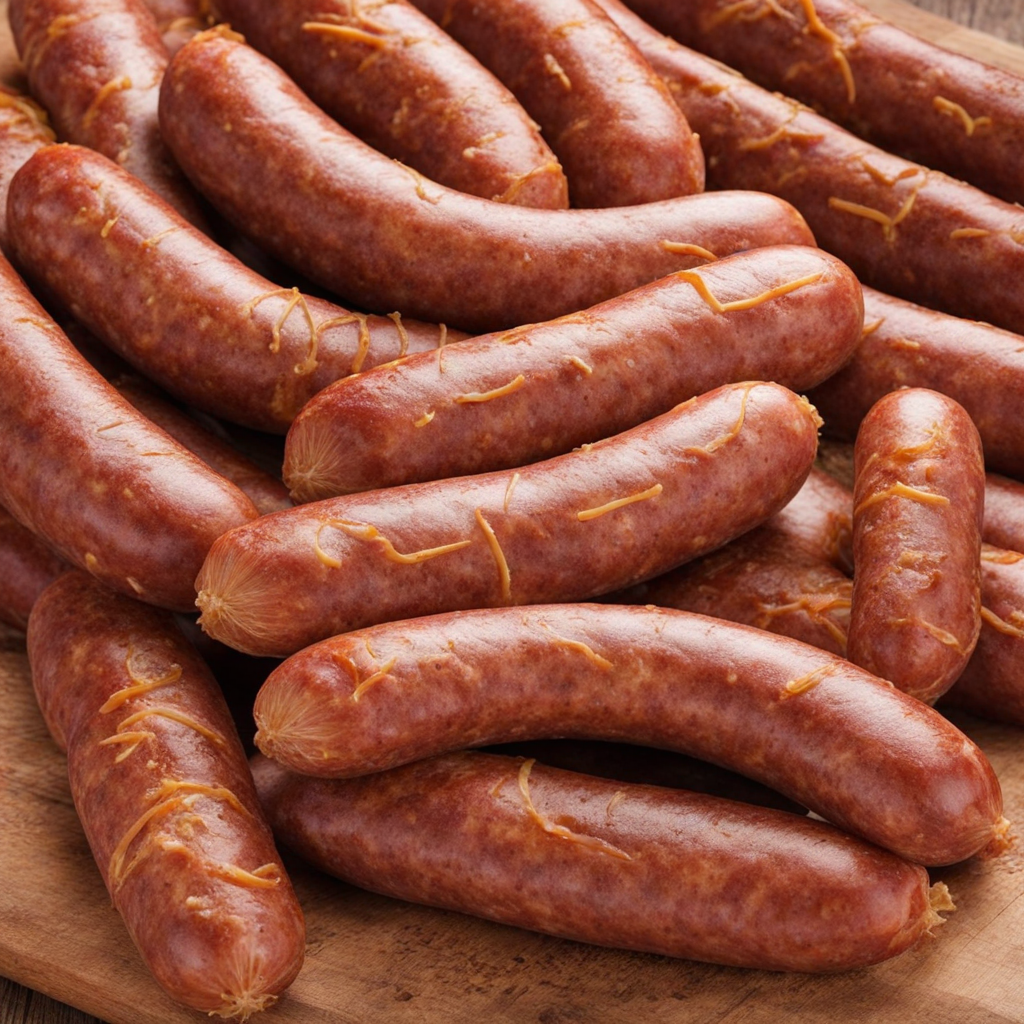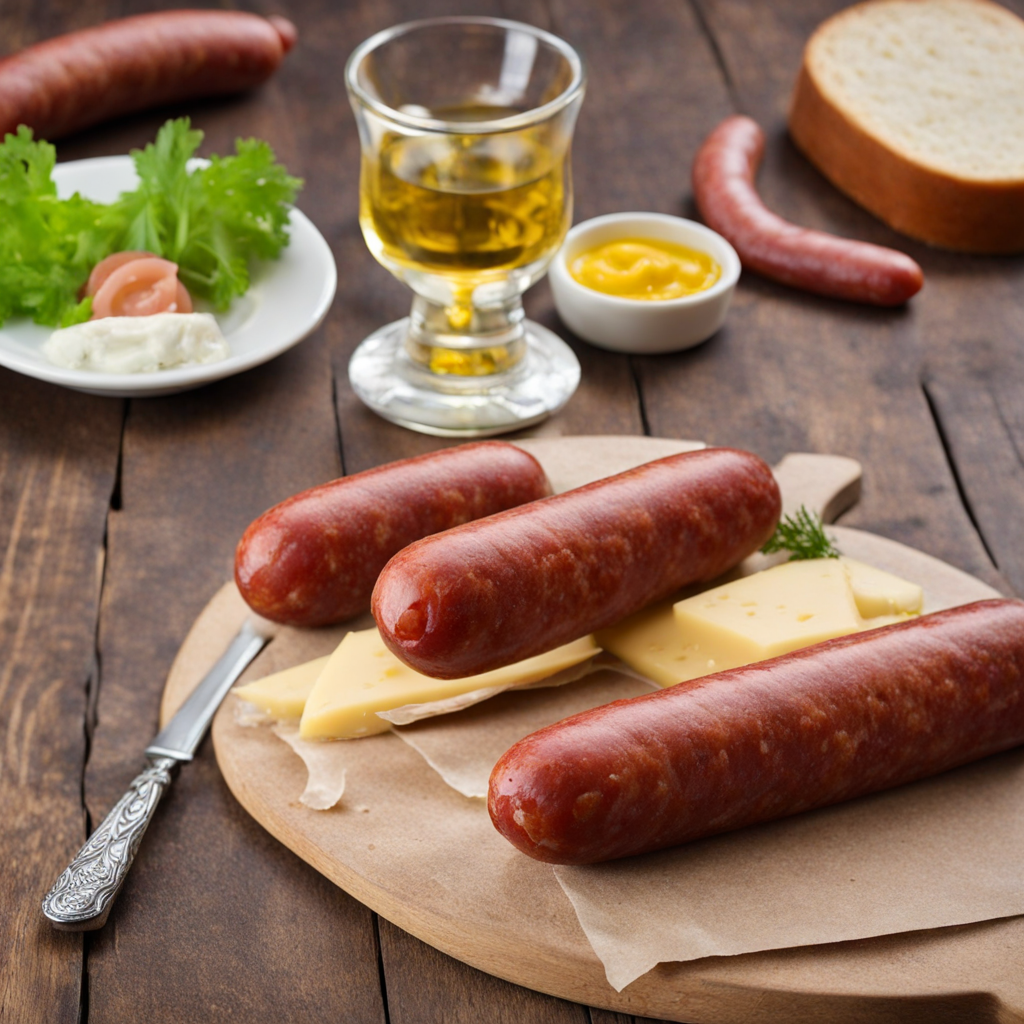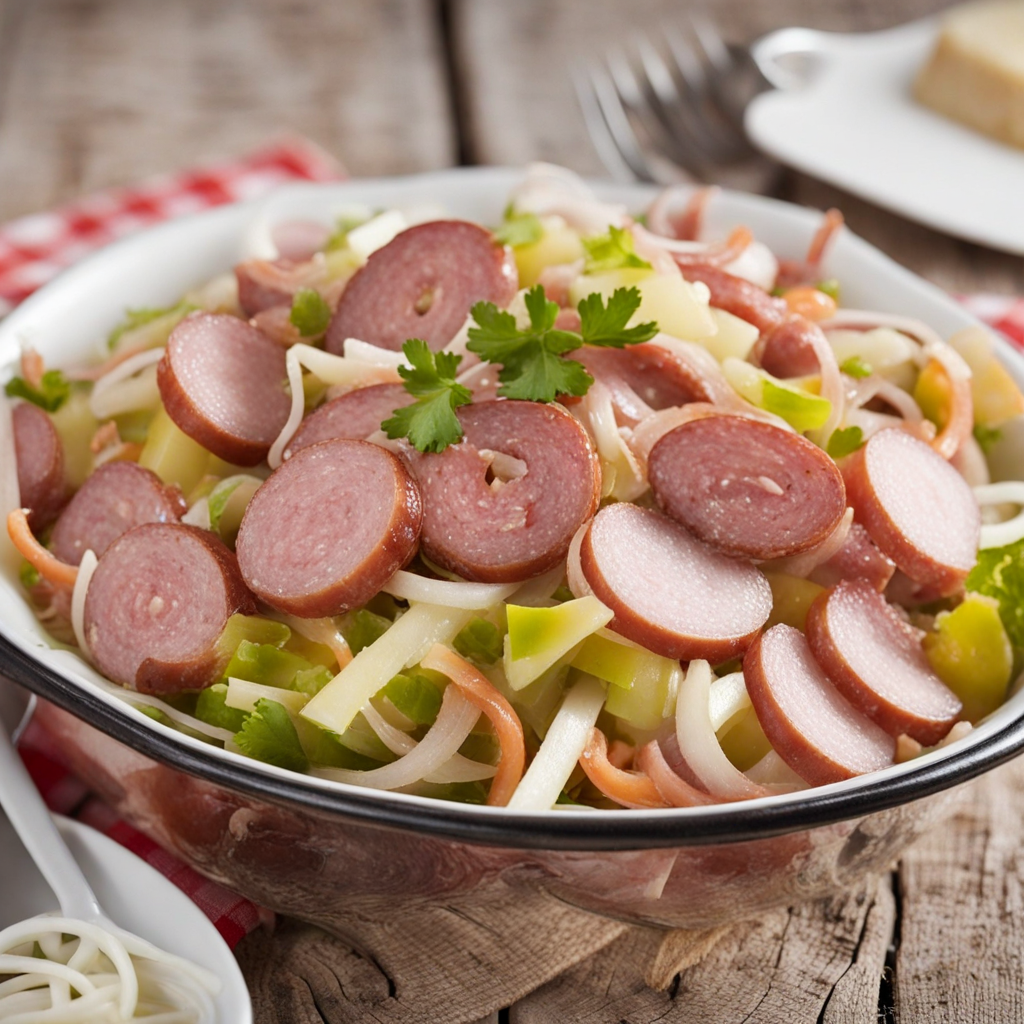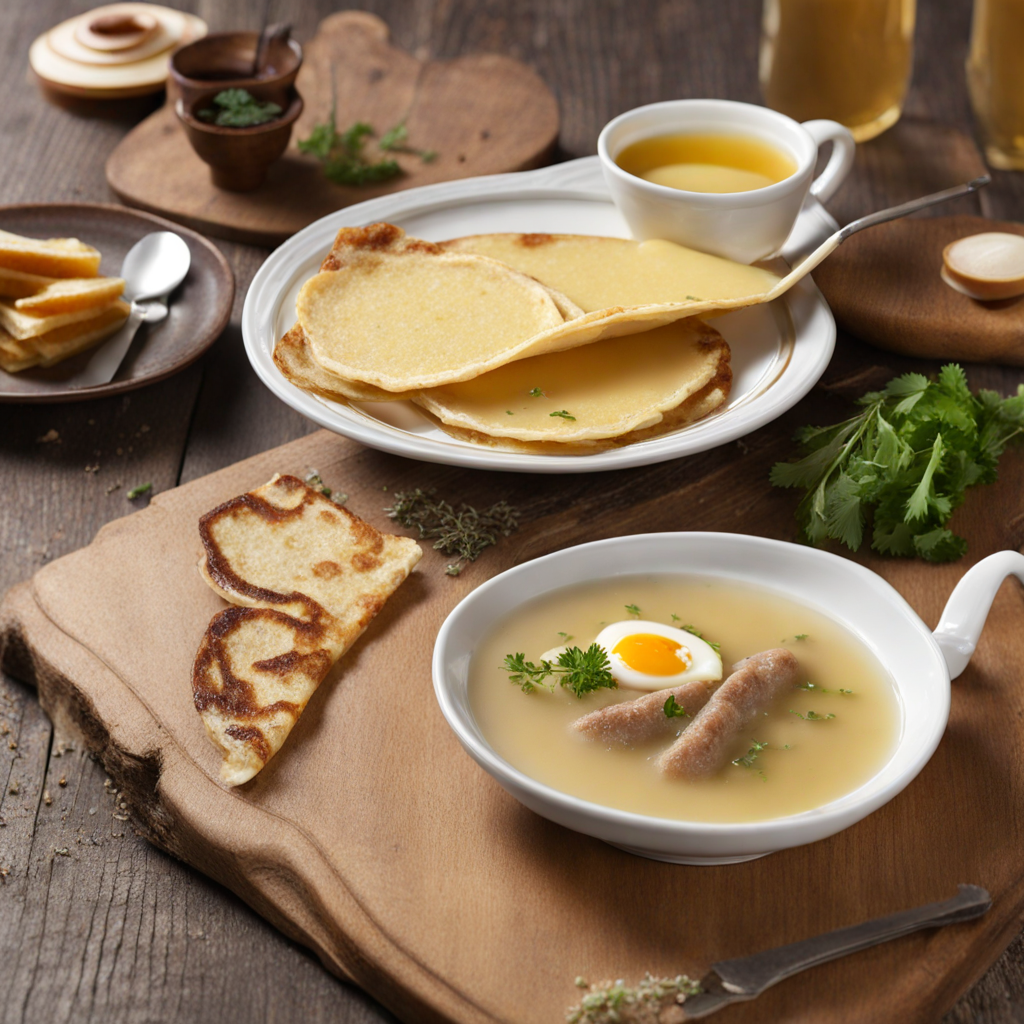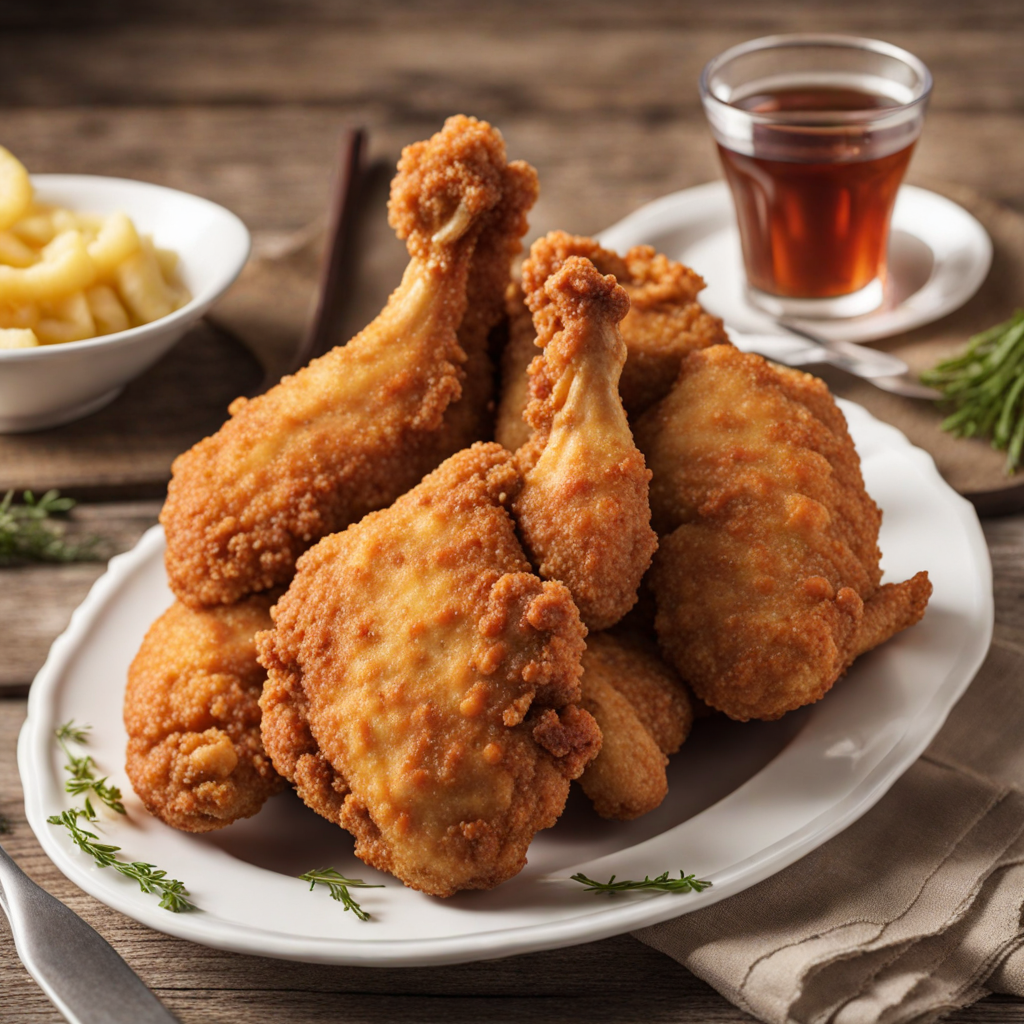Käsekrainer
Käsekrainer is a delightful Austrian sausage that combines the robust flavors of traditional pork sausage with the creamy richness of cheese. This unique culinary creation features finely minced pork that is seasoned with aromatic spices and then generously mixed with chunks of cheese, often Emmental or a similar variety. The resulting blend offers a tantalizing contrast between the savory, meaty exterior and the molten, gooey cheese inside, which melts to perfection when cooked, creating a luscious burst of flavor with each bite. Typically enjoyed grilled or pan-fried, Käsekrainer is best served in a crusty bread roll, topped with tangy mustard and fresh horseradish or even sauerkraut. The crispy exterior provides a satisfying crunch, while the warm, cheesy interior oozes out, adding an indulgent touch to the experience. This dish is not only popular among locals but also a favorite among visitors, who often indulge in it during street fairs, outdoor markets, and casual gatherings. Käsekrainer represents a unique fusion of flavors that showcases the heartiness of Austrian cuisine while also incorporating a playful element with its cheesy surprise. This sausage is more than just a meal; it’s an experience that invites you to savor the rich culinary heritage of Austria. Whether enjoyed as a quick snack or part of a larger feast, Käsekrainer is sure to tantalize your taste buds and leave you craving more.
How It Became This Dish
The Käsekrainer: A Culinary Journey through Austria The Käsekrainer is not just a sausage; it is a savory testament to Austria's rich culinary heritage and a beloved staple that has graced street markets and family gatherings alike. This delightful delicacy, which translates to "cheese krainer," is emblematic of the country's penchant for hearty, flavorful fare that is often enjoyed in convivial settings. To truly appreciate Käsekrainer, one must delve into its origins, cultural significance, and evolution over the years. #### Origins: A Sausage with Roots The Käsekrainer has its origins in the Krainer sausage, a traditional Slovene sausage that hails from the region of Carniola (Krain in German). This area, nestled between Slovenia and Austria, has a long-standing tradition of sausage-making, with recipes passed down through generations. The Krainer sausage itself is typically made from a mixture of pork, beef, and spices, encased in a natural hog casing, and is known for its robust flavor and coarsely ground texture. The addition of cheese, specifically Emmental or similar varieties, to the Krainer sausage is believed to have originated in the mid-20th century. As Austrian butchers experimented with their recipes, the Käsekrainer emerged as a delightful variation that appealed to the palates of both locals and visitors. The melted cheese inside the sausage creates a delightful contrast to the savory meat, resulting in a burst of flavor with each bite. #### Cultural Significance: A Symbol of Austrian Identity In Austria, the Käsekrainer is more than just a popular food item; it embodies a cultural identity that reflects the country's love for hearty, communal meals. Often found at street stalls, markets, and local festivals, the Käsekrainer is a quintessential part of Austrian street food culture. It is typically grilled to perfection, served in a bun, and accompanied by mustard, horseradish, or a tangy sauerkraut. This simple yet satisfying dish has become a symbol of warmth and conviviality, often enjoyed during leisurely outings, family picnics, or festive gatherings. The Käsekrainer is also an essential component of Austrian holiday celebrations. During events like Christmas markets, the aroma of sizzling sausages fills the air, drawing in crowds eager to indulge in this beloved treat. The act of sharing food, particularly sausages, is deeply rooted in Austrian traditions, fostering a sense of community and togetherness. The Käsekrainer, with its gooey cheese and smoky flavor, serves as a delicious reminder of the joys of shared meals. #### Development Over Time: From Street Food to Gourmet Delicacy The evolution of the Käsekrainer mirrors broader trends in Austrian cuisine and society. In the post-World War II era, as Austria underwent significant economic changes, the popularity of street food surged, spurred by urbanization and the growing fast-food culture. The Käsekrainer found its place in this new landscape, becoming a convenient and satisfying option for busy city dwellers and tourists alike. In recent years, the Käsekrainer has also experienced a renaissance of sorts, as chefs and food enthusiasts seek to elevate traditional foods to gourmet status. Artisanal butchers have begun to experiment with high-quality ingredients, crafting Käsekrainers that feature local cheeses, organic meats, and creative spice blends. This trend has given rise to a new wave of gourmet food stalls and pop-up restaurants that celebrate the Käsekrainer while honoring its traditional roots. Moreover, the Käsekrainer has transcended its humble street food origins to become a versatile ingredient in contemporary Austrian cuisine. Chefs are incorporating it into various dishes, from lavish brunch spreads to sophisticated charcuterie boards. The sausage's rich flavor and unique texture make it an ideal complement to a range of accompaniments, allowing for culinary creativity while maintaining a sense of tradition. #### International Appeal: A Taste of Austria Abroad As globalization has expanded the reach of culinary traditions, the Käsekrainer has found its way beyond Austria's borders. Austrian expatriates and food enthusiasts around the world have introduced this delightful sausage to new audiences, leading to its inclusion in international food festivals and European markets. In places with significant Austrian or Central European populations, such as parts of Germany, the United States, and Australia, the Käsekrainer has become a cherished item, evoking nostalgia for those familiar with its flavors. Moreover, with the rise of food tourism, many visitors to Austria seek out authentic culinary experiences, making the Käsekrainer a must-try dish during their travels. Tourists flock to traditional markets and street vendors, eager to sample this iconic sausage, often sharing their experiences on social media, further amplifying its popularity. #### Conclusion: A Timeless Treasure The Käsekrainer is more than just a sausage; it is a cultural artifact that encapsulates the essence of Austrian culinary traditions. From its humble beginnings rooted in the Krainer sausage to its status as a beloved street food and gourmet delicacy, the Käsekrainer has evolved while remaining true to its origins. It represents a celebration of community, tradition, and the simple pleasures of sharing a delicious meal. As Austria continues to embrace its culinary heritage while adapting to contemporary tastes, the Käsekrainer will undoubtedly remain a cherished symbol of its rich and diverse food culture. Whether enjoyed at a bustling market, a family barbecue, or a fine dining restaurant, the Käsekrainer stands as a delicious reminder of the power of food to bring people together, bridging gaps between generations and cultures, one flavorful bite at a time.
You may like
Discover local flavors from Austria


